Whether you are confused about the differences between LCD and LED, or whether you don’t know exactly which one is better for you, this post aims to shed light on the key differences, exploring their characteristic, price, brand recommendation, etc. Reading this post can help you intuitively understand the differences between LED and LCD and make an informed decision.
1.What is LED and LCD?
2.The Differences Between LCD and LED
3.Pros and Cons of LED Displays and LCD Displays
4.LCD VS LED Display: Which is Better in Different Contexts
5.LCD VS LED Display: Factors to Consider When Buying
6.Troubleshooting and Maintenance of LEDs and LCDs
7.2025 Most Popular China LED Display Suppliers Recommendation
8.FAQs
9.In Conclusion
1. What is LED and LCD?
Simply put, LED and LCD are two different display technologies. Below we will explain the definition of LED, and LCD, and how they work, giving you an initial recognition of the LED and LCD meaning.
1.1 What is LED
LED is a type of semiconductor called “Light Emitting Diode“, which is a small, energy-efficient light source that emits light when an electrical current passes through it, offering a long lifespan and vibrant colors. It is usually used in the display because of its precise control of the backlighting.
An LED display is a screen that uses LEDs either as backlighting in traditional LCD panels or as individual light-emitting elements to form the image itself. These displays take advantage of the energy efficiency, brightness, and color accuracy of LEDs, providing sharper images, better contrast, and lower power consumption compared to older display technologies.
1.1.2 How Does an LED Emit Light?
LEDs (Light Emitting Diodes), unlike conventional light sources that convert electrical power into heat, and then light, convert electrical energy directly to light. This results in a highly efficient light emitting with minimal amount of energy.
LEDs are light-emitting semiconductors that combine an N-type (with high electron concentration) semiconductor and a P type (with high holes concentration) semiconductor. The PN junction is created by applying a sufficiently high forward voltage. This causes the electrons to recombine with the holes.
1.1.3 Types of LEDs
Here is a list of different types of LED(Light Emitting Diodes):
- Micro LEDs
- High-power LEDs
- Flash LEDs
- Bi-color LEDs and Tri-color LEDs
- Red, green, and blue LEDs
- Alphanumeric LEDs
- Lighting LEDs
1.2 What is LCD
LCD (Liquid Crystal Display) is a technology that uses liquid crystals to control the light passing through them, creating images or text when illuminated by a backlight.
The liquid crystals in an LCD display don’t emit light themselves but rely on a backlight, often provided by fluorescent lamps (CCFLs), to illuminate the image. The LCD displays are known for their thin profile, energy efficiency, and high-quality image reproduction, making them widely used in televisions, computer monitors, smartphones, and many other devices.
1.2.2 How Does an LCD Emit Light?
LCDs (Liquid Crystal Displays) work by using liquid crystals to control the passage of light across the screen. The display consists of several layers, including a backlight, a polarising filter, a liquid crystal layer and a colour filter.
The backlight, usually made of LEDs, is used to provide the light that illuminates the screen. As current passes through the liquid crystals, their arrangement changes to allow different amounts of light to pass through.
The liquid crystals themselves do not emit light but can control the amount of light that passes through each pixel. The light that passes through the liquid crystal then passes through colour filters (red, green and blue) which combine to form the full spectrum.
By adjusting the intensity of light at each pixel, LCDs can display images and text on the screen. The result is a clear, colourful and energy-efficient display.
1.2.3 Types of LCDs
Below is a list of different types of LCDs(Liquid Crystal Display):
- In Panel Switching Displays(IPS Panels)
- Advanced Fringe Field Switching (AFFS)
- Vertical Alignment Panels (VA Panels)
- Twisted Nematic (TN)
- Blue Phase LCDs
- Quantum Dot LCDs
2.The Differences Between LCD and LED
Light-emitting diode and liquid crystal display are two terms to describe types of display technology. Here are the key differences between LCD and LED. Additionally, we will conclude their pros and cons to give you an insight into LCD and LED.
LCD vs LED Comparison Chart:
(1) Technology(Backlighting)
| LED | LCD |
| While an LED display is still technically an LCD, it uses light-emitting diodes (LEDs) instead of CCFLs for backlighting. This makes LED displays more energy efficient, and thinner, and provides better contrast and brightness. | LCD screens use fluorescent lamps (CCFL – cold cathode fluorescent lamps) as a backlight. The liquid crystals in the display do not produce light. Instead, they manipulate the light passing through the backlight to create an image. |
(2) Visual Quality
|
LED |
LCD |
| LED technology allows for higher brightness and contrast. In particular, full-array LED displays can provide local dimming, turning off LEDs in specific areas to achieve deeper blacks and better overall contrast. | Using a CCFL limits brightness and contrast, which is lower compared to LED displays. Achieving deeper blacks can be challenging because the CCFL is always on and affects contrast. |
(3) Power Consumption
| LED |
LCD |
| LED display is more energy efficient, reducing heat generation and power consumption while maintaining high brightness. | LCD displays consume more power, especially at higher brightness levels, due to the use of CCFLs, which are less efficient than LEDs. |
(4) Longevity
| LED |
LCD |
| LED display is durable and has a long service life. The working life of LED displays is about 100,000 hours. | The average service life of LCDs is about 50,000 hours. Therefore, the lifespan of LCDs is shorter than LEDs. |
(5) Gaming Application
| LED |
LCD |
| LED displays have higher refresh rates, resulting in better performance with minimal lag and ghosting issues in graphic-intensive games. It can provide a best gaming experience than LCD. | A monitor with a low response time and high refresh rate, an in-plane-switching (IPS) panel, as well as a feature for high dynamic video (HDR), would be ideal for gaming. |
(6) Cost
| LED |
LCD |
| LED screens, especially those with advanced backlighting technologies like full array, tend to be more expensive due to the higher cost of LED components and improved performance. | Compared with LED screens, LCD displays are less expensive, especially older models that still use CCFLs. |
3. Pros and Cons of LED Displays and LCD Displays
Through the comparison chart above, I think you have known the key differences between LED and LCD. Next, we will further explain their respective advantages and disadvantages to help you quickly find the display you need.
3.1 LED Display Advantages
3.1.1 Flexible in Shape and Size
LED displays are modular with a flexible structure. Therefore, they can fitted and customized to different shapes and sizes. Whether it’s vertical, horizontal or sphere-shaped, it provides unparalleled flexibility in design and configuration. Users can tailor their visual experience to specific requirements and environments.
3.1.2 120°-160°Viewing Angles
The compact LED chips allow LED displays to produce a denser light, and increase the viewing angle (120° – 160°). It is not necessary to use polarizing filters for the LED display to produce images. This allows it to maintain consistency in brightness and color accuracy over a wide viewing angle.
3.1.3 High Brightness, Contrast, and Color Accuracy
LED displays offer superior brightness levels, contrast ratios, and color accuracy, especially with local dimming technology, which allows for deeper blacks, vibrant colors, and realistic images.
3.1.4 Thinner Design
LED technology allows for ultra-thin displays, with aluminum alloy cabinet structures, which makes LED displays ideal for modern, sleek designs in everything from televisions to digital billboards.
3.1.5 Long Lifespan
The LED displays have a longer lifespan compared to traditional backlighting options like CCFLs. They typically last 100,000 hours, reducing the need for frequent replacements.
3.2 LED Screen Disadvantages
3.2.1 Light Pollution
Due to its excellent light density, it can cause light pollution. Light pollution occurs when there are too many artificial light sources that block and interfere with the natural light in the environment. Too much artificial light can also affect sleep cycles and eye health.
3.2.2 Higher Initial Cost
LED displays, especially those with advanced features like Full-array or OLED, are typically more expensive than traditional LCD displays with CCFL backlighting.
3.2.3 Cause Eye Fatigue
The lower refresh rate of LED screens usually flickering, picture incoherence and other problems, the burden on the eyes is also relatively large, thus causing eye fatigue.
3.2.4 Possible Screen Flicker
Some LED displays may experience flickering, especially at lower brightness levels or when used with certain types of dimming technology, which can be noticeable to sensitive viewers.
3.3 LCD Panel Advantages
3.3.1 Low Heat Emission
LCDs generate very little heat compared to older CRT displays, contributing to a more comfortable viewing environment and extending the life of the device.
3.3.2 Affordability
LCD display is often more affordable (depending on the model) than other advanced display technologies such as OLEDs or LEDs, making it an attractive option for budget-conscious consumers.
3.3.3 No Screen Burn-In
Unlike OLED displays, which can suffer from permanent screen burn-in, especially for still images, LCD screens do not suffer from this problem, making them more durable and suitable for continuous use.
3.4 LCD Panel Disadvantages
3.4.1 Limited Contrast and Black Levels
One of the biggest drawbacks of LCD displays is their inability to render true blacks. Because LCD monitors rely on backlighting, some light leaks out even in darker areas of the screen, resulting in faded blacks and a lower contrast ratio compared to technologies like OLED or plasma.
3.4.2 Thicker and Heavier
Although LCDs are thinner than CRTs, those with older backlighting technologies (such as CCFL) or larger screens can still be bulkier compared to the ultra-thin designs of modern OLEDs and LED-backlit models.
3.4.3 Dependence on Backlighting
Since LCDs rely on external backlighting (whether CCFL or LED), they cannot achieve the self-emissive pixel technology that OLEDs offer, which means that black levels and overall contrast are limited by the backlight’s performance.
3.4.4 Poor Viewing Angle
Older or lower-end LCD models tend to suffer from poor viewing angles, meaning the image quality can degrade when viewed from the side. Colors and brightness can appear distorted, especially in cheaper displays.
4. LCD VS LED Display: Which is Better in Different Contexts
The decision between LED and LCD displays will ultimately depend on your needs and priorities. Both technologies have distinct advantages and disadvantages. Here’s the conclusion on which one may be better in different contexts.
4.1 For General Use
LED displays, particularly when paired with full-array local dimming or OLED, can provide better image quality, deeper blacks, and more vibrant colors, making them ideal for most applications such as exhibitions, stores, cinemas, airports, etc.
4.2 For Budget-Conscious Customers
LCD displays may be the better option for those on a budget. While modern LED-backlit LCD displays offer improved performance, traditional CCFL-backlit LCDs are usually more affordable. For those who don’t need the highest image quality or advanced features like HDR, an LCD display can offer good value.
4.3 For Outdoor Environment
The displays used in outdoor environments require high brightness and contrast to ensure picture quality and clarity. Therefore, LED displays are typically superior in brightness and contrast levels, which are the best choice for environments with high ambient light.
4.4 For Rental Use
For the purpose of rental, the display needs durability, portability, and flexibility in sizes and shapes. LED screens are typically thinner, and lighter, and allow for customization to fit your specific events.
5. LCD VS LED Display: Factors to Consider When Buying
As an event organizer, choosing the right display technology—whether LED or LCD—is crucial for ensuring the success of your event. Here are the key factors to consider when deciding which display to buy:
5.1 Purpose and Application
LED panel: ideal for dynamic, high-impact displays such as large event backdrops, digital signage or concert stages. If your event requires high visibility and engaging visuals, LEDs are the way to go.
LCD panel: Perfect for static content, presentations or smaller event screens. If your display needs are more immediate and focused on delivering slides, video or informational content, LCD may be sufficient.
5.2 Cost and Budget
LED displays: are generally more expensive, especially for larger or higher-quality models. If budget is an issue, LED displays can be a significant investment, but their durability and visual impact can justify the cost.
LCD displays: Often more affordable than LEDs, especially for smaller or lower-end models. If your event budget is tight and you don’t need large displays, LCDs may offer a more economical option.
5.3 Size and Viewing Angle
LED screen: It is perfect for large-scale events such as outdoor concerts, trade shows, or stadium displays. Meanwhile, it provides wider viewing angles and remains clear even at longer distances.
LCD screen: It is suitable for fixed sizes and is generally less customizable. Compared with LED screens, LCD screens have limited viewing angles. The image quality may degrade when viewed from the side.
5.4 Brightness, Contrast, and Color Accuracy
LED display: It features higher brightness, a higher contrast ratio, and precise color accuracy, resulting in HD image quality even in outdoor or well-lit environments.
LCD display: It is the opposite of an LED display. It doesn’t perform well in direct sunlight or very bright environments and is better suited for indoor use.
5.5 Installation and Maintenance
LCD screen: It is easier and faster for fixed installation. LED displays require more frequent maintenance or replacement because of a shorter lifespan.
LED screen: The installation of an LED screen may be more complex for large setups or custom configurations. LED displays are known for their longevity, so they require less maintenance over time.
6.Troubleshooting and Maintenance of LED and LCD
6.1 LCDs and LEDs Maintenance Tips
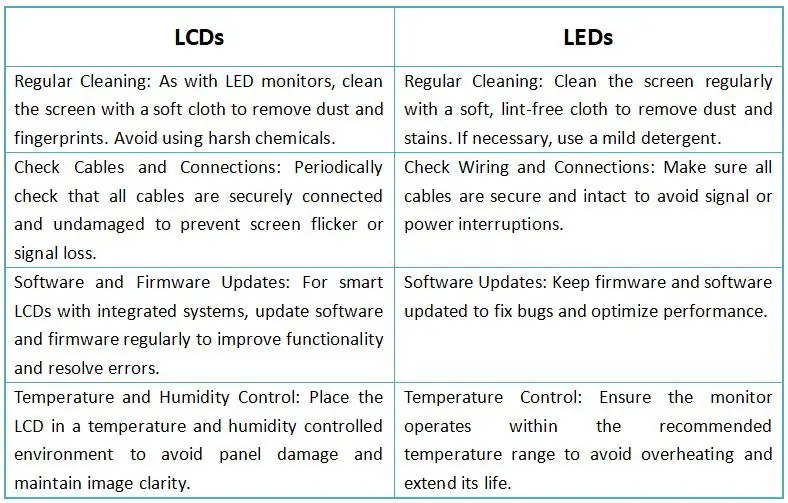
6.2 LCDs and LEDs Common Issues and Solutions
6.2.1 LEDs Common Issues and Solutions
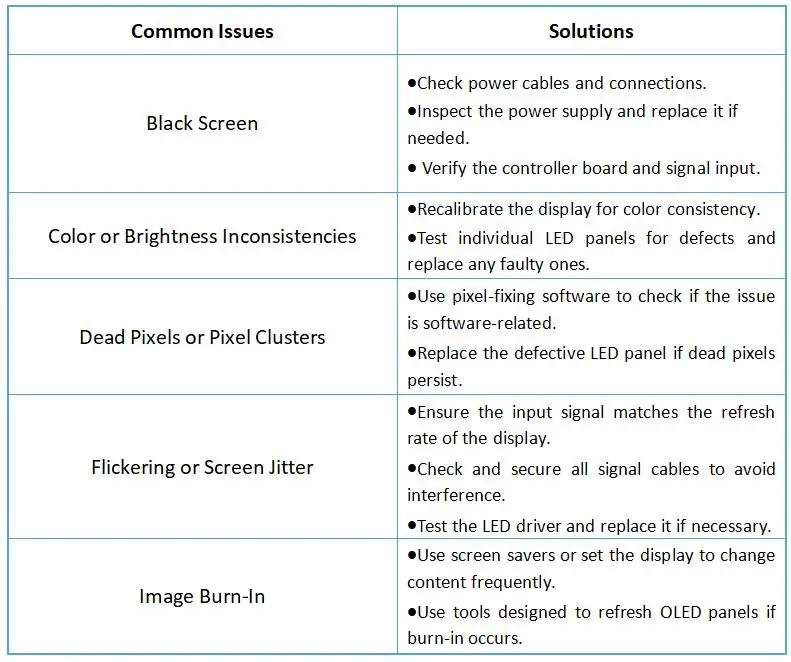
6.2.2 LCDs Common Issues and Solutions
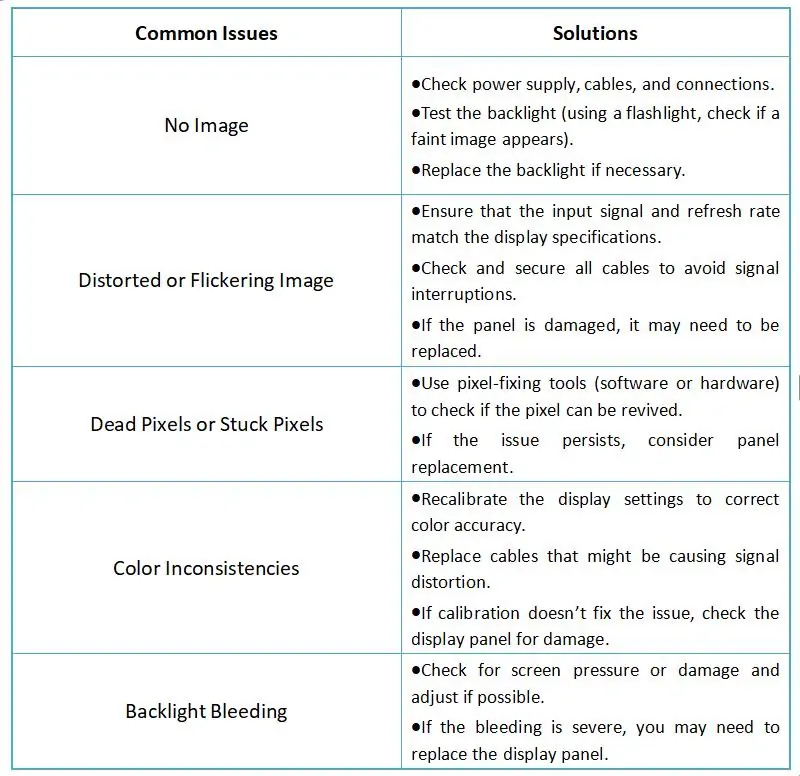
7. 2025 Most Popular China LED Display Suppliers Recommendation
If you are looking for a reliable LED display supplier, we recommend these top 5 China LED screen manufacturers in 2025. This recommendation will be a useful reference to help you find the right partner.
7.1 Shenzhen EagerLED
Founded in 2009, Shenzhen EagerLED Co., Ltd is a leading LED Display Manufacturer with Over 15 Years of Production and R&D Experience. EagerLED is a professional LED display solution provider with more than 5,000+ square metres of production and office area and customers from over 90 countries. All products are certified by ISO14001, ISO9001, ISO45001, FCC, CCC, RoHS and other global market certifications.
Website: https://www.eagerled.com/
Phone number: +86 15361038665 ; +86 755 23190947
Email: [email protected]
7.2 LINSNLED
Shenzhen Linsn LED Co., Ltd. was founded in 2008 with more than 12 years in LED display solutions manufacturing, R&D and selling. With strict quality control and advanced production ability, Linsn LED is able to provide reliable products and full LED solutions to customers worldwide and has already served 10,000+ customers around the world.

7.3 LianTronics
LianTronics was founded in 2003 and is now a leading LED solution provider. It specializes in LED application products, from development, manufacturing, to sales. LianTronics also has 200+ national patents and is an international enterprise that operates in 200+ countries.
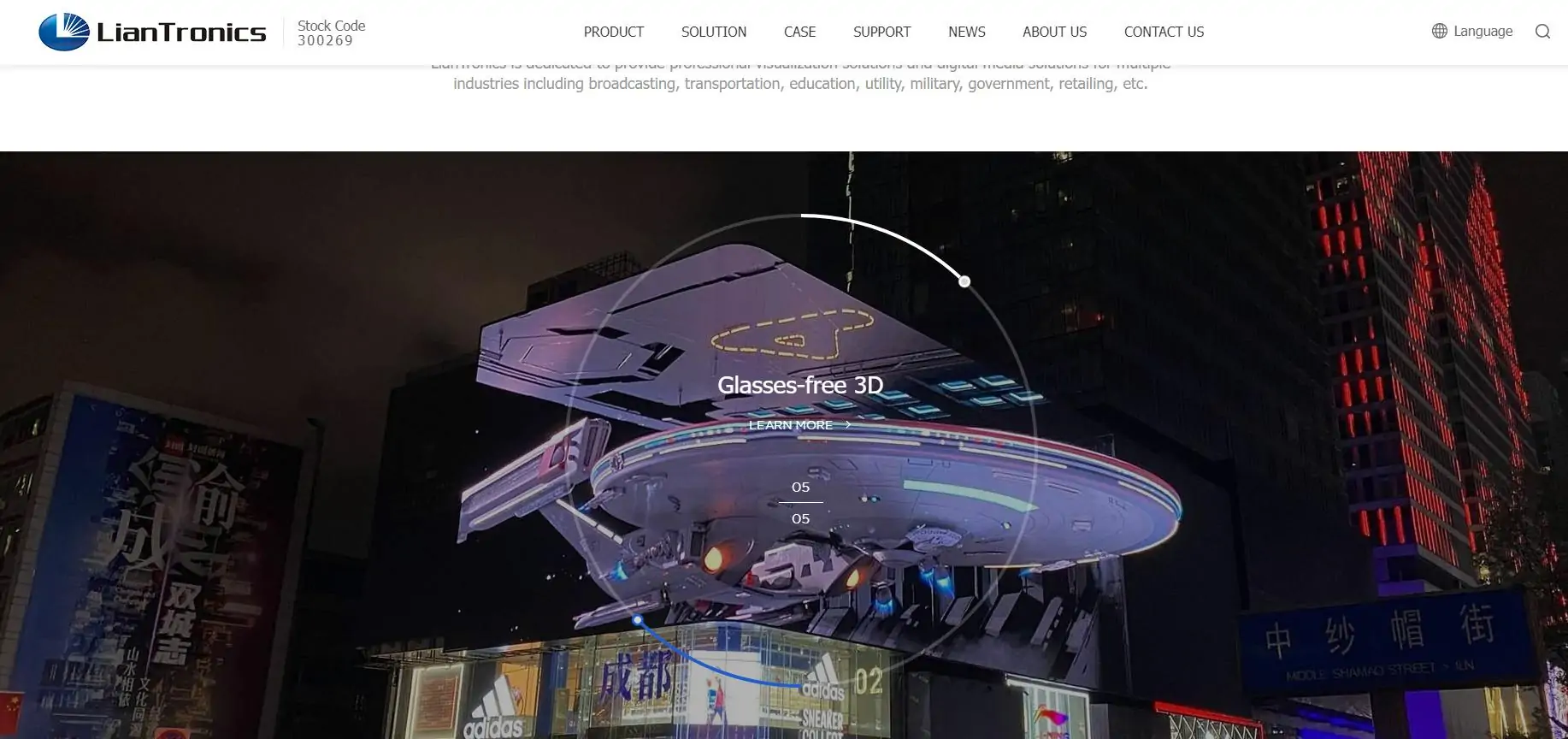
7.4 ROE Visual
ROE Visual was founded in Shenzhen in 2006, and has its headquarters in Shenzhen. The company is the world’s leading LED display technology leader, and specializes in designing, manufacturing and delivering high-performance LED wall displays for a variety of applications, including entertainment, sports and live events, corporate environments, and architectural installations.

7.5 NSELED
Founded in 2011, NSELED is a leading manufacturer and supplier of high-quality LED displays and digital signage solutions. NSE LED specializes in providing cutting-edge LED display solutions for various industries, including advertising, entertainment, sports, retail, and corporate environments.
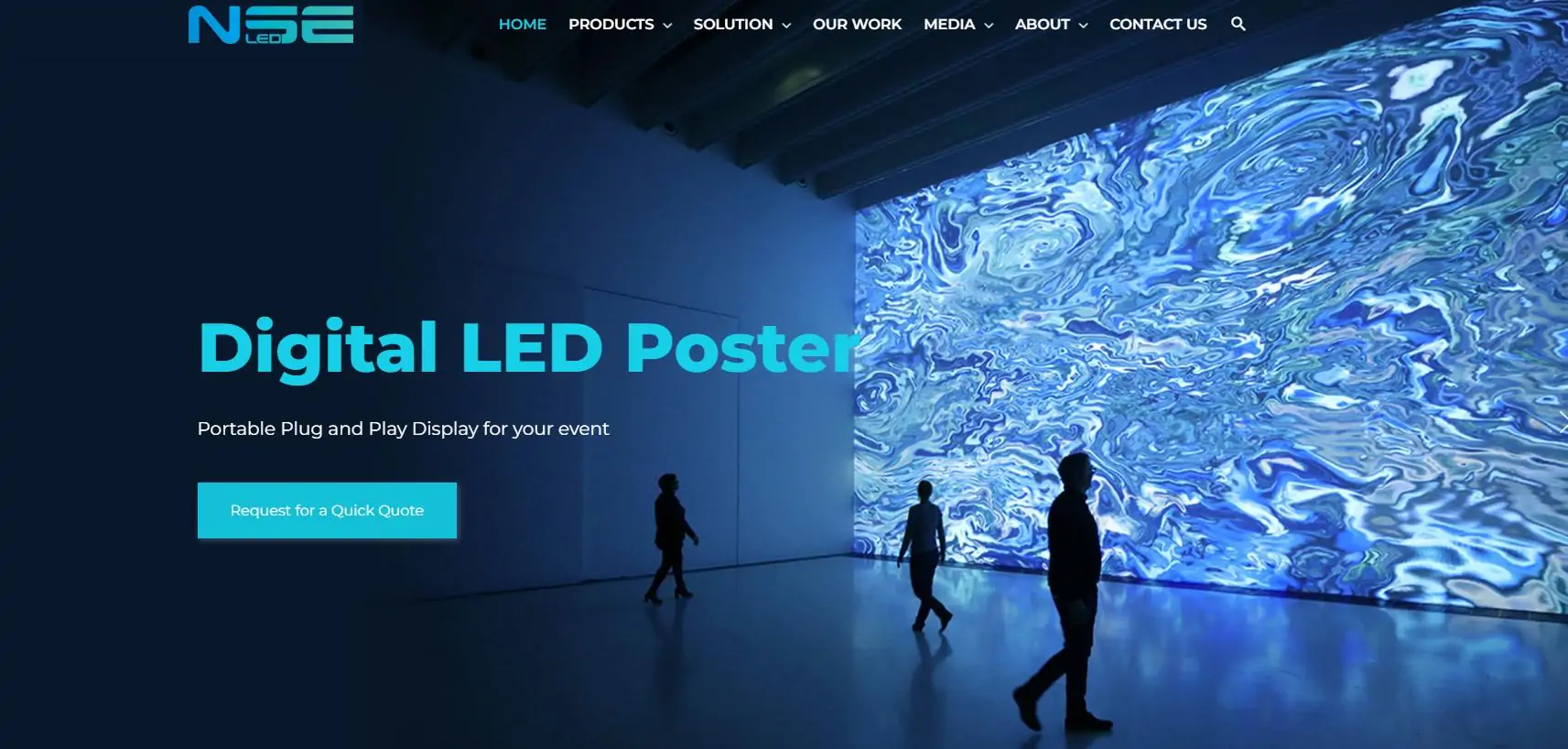
8. FAQs
1. Are LEDs More Expensive than LCDs?
Yes, LEDs are often more expensive than LCDs for their special backlighting technology, unique LED technology, long lifespan, etc. However, the cost difference depends on a variety of factors, including the type of LED technology, the size of the LED display, and the intended use.
2. LED VS LCD display: Which is best for gaming?
LED displays offer higher refresh rates. This results in a better performance, with less lag and ghosting in graphics-intensive games. Compared with LCD displays, the LED display is the best option for gaming.
3. Is LED or LCD Better for eyes?
Both types can cause eye strain. Respectively, the LED displays feature higher brightness and better contrast, which can help reduce eye fatigue. Therefore, LED displays provide customers with more comfortable viewing effects.
4. Is there a big difference between LED and LCD monitors?
Yes, a big difference between LED and LCD monitors is backlighting. LCD monitors use cold cathode fluorescent lamps for backlighting. LED monitors use light-emitting diodes for backlighting.
5. How to check if my screen is LCD or LED screen?
Check the Screen Edges and Thickness: LCD screen is relatively thick and has a noticeable frame. LED screen is thin and has a narrow frame.
Observe the Brightness and Contrast: Compared with LCD screens, the LED screens have higher brightness and contrast.
Look for Backlighting Type: If the specification mentions “LED Backlit”, it is an LED-backlit LCD. Otherwise, it is a standard LCD.
9. Conclusion
This post explains the differences between LCD and LED, and their advantages and disadvantages. At the same time, we also give you some tips about buying, maintenance, and manufacturer recommendations.
All in all, LED displays are advantageous due to their many features, including longer life span, lower power consumption, ease of maintenance, improved display performance, etc. The initial cost is higher because of these qualities, but the investment will be worth it in the end.
Considering them according to our specific needs is the best way to decide which one you should choose.































